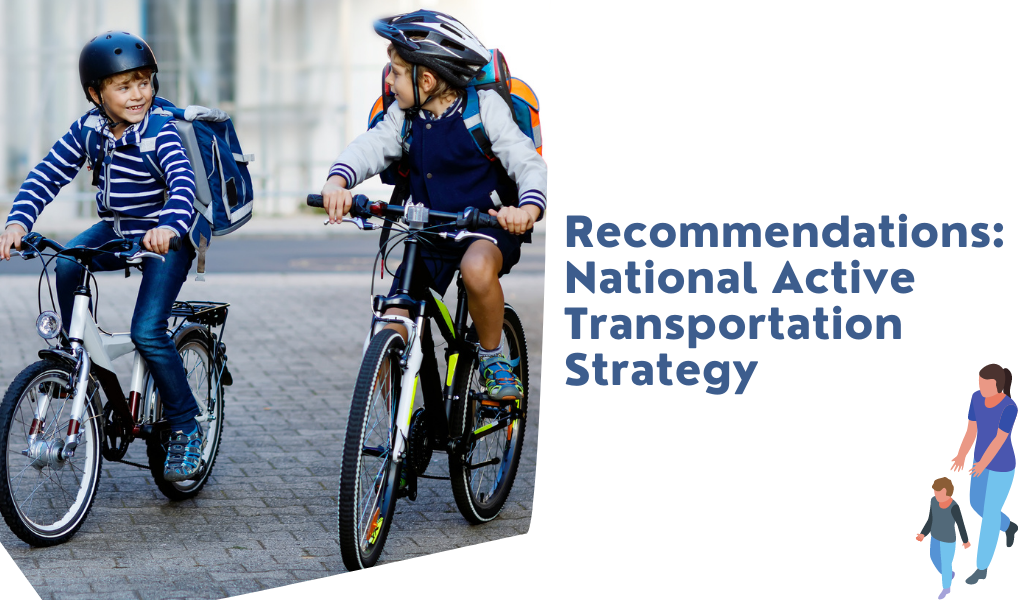Excerpts from the submission by the Active School Travel Canada Working Group to the Government of Canada regarding the proposed National Active Transportation Strategy and Fund.
Who we are
Active School Travel Canada (AST Canada) is an all-volunteer working group of over 60 professionals from across Canada who work in the realm of Active and Safe Routes to School, School Travel Planning, Transportation and Community Planning, and School Transportation. Our members are drawn from the non-profit, public, and private sectors. Our purpose is to build the capacity, expertise, and knowledge of group members, and advance active school travel (AST) initiatives across Canada by fostering networking, information sharing, and collaboration.
Active School Travel in Canada: overview
a. The issue
- Over the last few decades, the percentage of Canadian children regularly walking or cycling to and from school has fallen from an average of 75% in the 1980s to just 25% today.
- In most urban centres, this “school run” is a significant contributor to rush hour traffic volumes (most studies show 20-30% of morning peak period traffic are parents and caregivers driving children to school), increases in fine particulate matter emissions, as well as GHG emissions.
- While AST rates have remained higher among many BIPOC communities, these children and families must often contend with routes to school that are much more hostile for those on foot or bicycle thanks to generations of car centric street design.
b. The response
- Canada’s first Active & Safe Routes to School (ASRTS) pilot project was launched in Toronto in 1995. Over the next decade limited ASRTS initiatives spread to some other communities in ON, NS, QC, MB, and BC. These programs largely focused on Education & Encouragement initiatives.
- In 2007-09 the new Canadian School Travel Planning (STP) model was piloted at 12 schools in 4 provinces. School Travel Planning involves a more comprehensive approach using five E’s: Education, Encouragement, Engineering, Enforcement, and Evaluation.
- In 2010-12 the STP model was further refined during a national pilot project funded by the Public Heath Agency of Canada. STP projects were implemented in at least one community in every province and territory across the country.
c. Present situation
- Active School Travel and School Travel Planning programming in Canada is a limited patchwork that reaches a tiny fraction of the country’s +15,000 elementary and secondary school communities. Currently there is no programming occurring at all in Newfoundland and Labrador, Prince Edward Island, New Brunswick, Quebec, Saskatchewan, and all three territories.
- Funding for both infrastructure and programming is extremely limited, short-term, and unstable.
- There is no national coordination, funding, or data collection at present.
Our Recommendations:
- Ensure an equal voice for child and youth mobility: Currently the needs and perspectives of children and youth are mostly shut out of discussions and decisions regarding transportation planning and design, active transportation policy, and infrastructure investments. Youth engagement should be included as part of the National Strategy as well as projects funded through the National AT fund.
- Strengthen national coordination: As an all-volunteer working group, AST Canada lacks the capacity to properly engage and convene AST stakeholders across the country, share information and resources from the various programs operating in different communities, or to undertake and disseminate research. Establishing a small, professional coordinating body would be an important step towards improving the current patchwork approach of programs and initiatives.
- Infrastructure that supports Active School Travel: Targeted investments that prioritize making routes to school and school zones safer and more convenient for children who walk and wheel are urgently needed. This means the construction of connected networks of sidewalks, pathways and cycling lanes serving schools, safety improvements to existing facilities, and community wayfinding.
- Programming that supports Active School Travel: While AST research has shown that engineering improvements (such as improving intersections and adding sidewalks) are associated with walking or biking rates going up by 3.3 percent per year, and that education and encouragement programs were also associated with walking and biking going up by 1 percent per year, schools that combined engineering improvements with education and encouragement could potentially see increases in walking or biking of up to 43 percent over 5 years. For maximum impact, it is critical that infrastructure changes are accompanied by programming that encourages and educates utilization.
- Traffic calming in and around school zones: Traffic volumes as well as increases in vehicle sizes and speeds pose a serious safety hazard to all vulnerable road users, and children in particular. This needs to be addressed with investments that focus on improving the safety of school zones, major routes to school, and the surrounding residential areas where children and families are likely to be present. These targeted investments could include traffic calming infrastructure, the design and construction of complete streets, the creation of pedestrianized and traffic-free areas, and the reallocation of existing road space.
- Improved data collection: Currently the federal government (Statistics Canada) only captures and reports data on active transportation as it pertains to the journey to work (commuting), and walking/cycling are counted only if they represent the longest portion of that journey. Collection and reporting must be broadened to capture journeys to and from school (including multi-modal trips), seasonal variations in AST rates, transportation mode data in smaller geographic areas (including rural communities and reserves), and more diverse data characteristics including gender, age, immigrant status, and visible minorities.
- Vehicle design: SUVs and light trucks are a rapidly growing percentage of all vehicles on Canada’s roads, and most are becoming larger and more dangerous. Children and youth are especially vulnerable due to their shorter stature, and the strategy should identify the need for Transport Canada to develop policies and strategies that address this worrisome trend.
- Commit to dialogue with provinces & municipalities: Increasing rates of active school travel will also require more supportive land use and transportation planning policies that prioritize walking/cycling connectivity, as well as supportive facilities in existing and planned communities. While provinces and municipalities have key responsibilities in this area, the strategy should include a clear commitment to begin a dialogue with these other levels of government in order to build collaboration and further support for active school travel (as well as walking and cycling more generally.)
- Equity & Diversity: There is growing recognition that not all communities have benefitted equally from past AST and STP initiatives. It is important that we not only focus on mode share, but also on road safety as there are many schools (particularly in urban areas) that may have high walk/bike to school mode share due to low rates of vehicle ownership, but these residents may still face hostile and dangerous streets on the school journey. Equity efforts in the realm of AST should include engaging meaningfully with communities of colour through partnerships with trusted community leaders, celebrating diversity in the community, developing program elements that include children living with disabilities, and addressing concerns around personal safety, housing affordability, homelessness, and immigration.
We are excited to see these efforts increase the numbers of children and families able to engage in healthy and sustainable school travel, and ultimately improve the health, well-being, and safety of Canadians across the country in the years ahead.
Read the full letter here.

